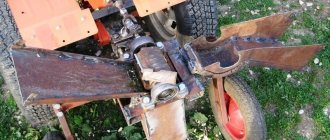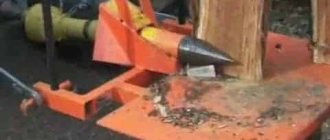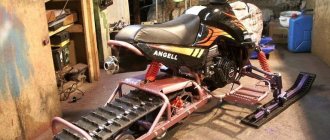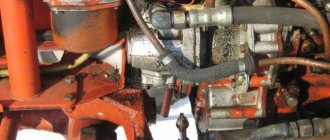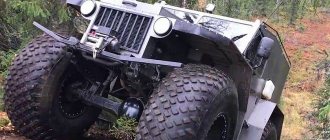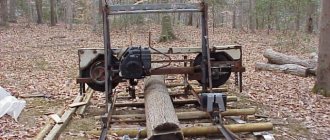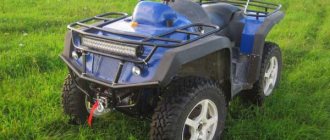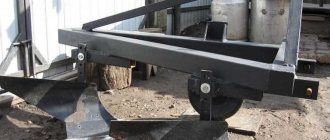Each driver personally decides for himself whether to buy tracks or make them himself. We will consider both aspects, but each of them is only advisable if the car drives not only on the highway. Tracks are a great way to increase a car’s off-road capability, and for many motorists such tuning is a necessity. Is it worth buying tracks for the Niva if you can make them yourself?
Problems with transporting incredibly heavy camp equipment and connecting hunting grounds to public transport are pressing for every hunter. An SUV, even one like the Niva, solves these problems only partially, since there remain obstacles in the form of gullies, slopes and off-road conditions that a car on standard wheels cannot cope with. There is an urgent need to convert your vehicles to caterpillar tracks. How to make tracks for a Niva in three ways, in which cases is it better to buy ready-made ones?
DIY caterpillar for a snowmobile or car. How to make a caterpillar with your own hands?
A DIY caterpillar can be made by any craftsman. If you have been thinking about how to make a caterpillar for a long time, then you should read the recommendations presented. To carry out the work, you can use a variety of tools and materials. It is, of course, permissible, if necessary, to use a caterpillar that was produced in a factory. But it will cost much more than if you do the manufacturing yourself. The article will present several options for making tracks, one of which you can choose for yourself.
Recommendations for carrying out work
A caterpillar can be made with your own hands by connecting elements into a single ring; this can be done in several ways. So, it is permissible to use a hinge like a piano hinge; you can also use a less reliable method, which involves sewing on the ends of the tape. It is important to note that the thickness of the tape must be selected, which corresponds to the power of the motor. If you intend to use an engine from a domestically produced motorcycle, then you can use a tape whose thickness is 10 mm, similar to that used on agricultural conveyors.
If you make your own caterpillar using this technology, you won’t have to spend a lot of effort. Despite the fact that this model of caterpillar is quite simple to make, it has a long service life and a long service life.
Making caterpillars from car tires
In order to spend less effort when making a caterpillar for a car with your own hands, you can wet the blade from time to time using a soap solution. As an alternative solution, you can use a device designed for cutting; it is also possible to use an electric jigsaw. On the latter you first need to attach a file with small teeth, the file must also be pre-moistened with water, during the work such manipulations must be done periodically.
Work technology
Do-it-yourself tracks for a car must be made using a technology that involves the initial removal of the tire beads, then, if necessary, you need to remove the excess layers that are located on the wrong side of the formed ring; this is necessary if the track has increased hardness. If the tread pattern is not suitable, then you need to cut a new structure, which will be necessary so that the structure can cling to the soil.
A snowmobile track made with your own hands according to the scheme described above will have many advantages, even if compared with the option described above. This is due to the fact that it has a closed loop, which indicates reliability. But there are also disadvantages, one of which is expressed in the limited width of the track, but if there is a need, then a double width can be used.
Another option for making a caterpillar
Before you make a caterpillar with your own hands, you need to choose a technology for carrying out the work. It is also possible to use the method presented below. The propulsion frame can be welded using pipes that have a rectangular cross-section. It is recommended to connect them using a frame, this will make the structure collapsible. The splined part can be borrowed from the Buran, this will make it possible to make drive shafts; the splined part of the shafts, which are borrowed from the Oka, must be welded to them. It will also be necessary to use brake discs. When working on the front shafts, you need to install brake mechanisms on them. Some part of the gearbox housing needs to be cut off. Making a caterpillar with your own hands will allow you not only to save money, but also to move through snowy areas without any problems. This design can be used for a long time without the need for repairs.
Source
Tracked module on a car
Greetings, friends! Today we’ll look at the seemingly hackneyed topic of increasing a car’s cross-country ability. But let's talk about a very non-standard way to improve the performance of equipment - installing a caterpillar drive instead of wheels. In general, the advantages of the caterpillar as a propulsion device are obvious - low ground pressure and, therefore, high cross-country ability. This is clearly demonstrated in the following video, where the tracked all-terrain vehicle has not only excellent maneuverability, but also decent speed.
A little history
Installing tracks on a regular car is not a new idea. This was done at the beginning of the last century. Adolphe Kegresse, a Frenchman who was the personal driver of Nicholas II until the revolution, achieved significant success in this. The so-called Kegress propulsion system is a tracked module that is attached to the drive axle of the car instead of wheels. Special skis could be installed on non-driving wheels, which turned the car into a snowmobile. Such an off-road tracked propulsion unit (OCT) gained enormous popularity, especially during the Second World War.
Kegress mover
Design Features
A modern tracked module for a car is a simple design that is installed instead of wheels. There is nothing fundamentally new in this design - in fact, it is an improved and lightweight Kegress propulsion unit. Typically the module is triangular in shape and consists of a frame, rollers, a drive sprocket and a track similar to a snowmobile.
Thanks to its triangular shape, the device fits easily into the wheel arch, eliminating the need for any modifications to the car. To prevent the module from turning due to excess torque, it is often secured using cables or chains.
The device can have a different shape, and is also designed in such a way that there is no need to even remove the wheels. The car simply drives onto the modules, they are attached and you are good to go. Of course, such tracks on car wheels are not a cheap pleasure. The kit will cost no less than 150-200 thousand rubles. The price of devices from foreign manufacturers can reach up to 700-800 thousand rubles per set, which is higher than the cost of a new UAZ. Of course, many people try to make a tracked module with their own hands, and often they even succeed.
Main advantages
The advantages are obvious - improved cross-country ability. As well as an increase in ground clearance. Deep snow in the fields, swamps of small swamps, and simply “well” washed out roads become easy obstacles. If we take into account what these tracks were originally developed for, it was to overcome deep snow, they were made for rescuers on mountain roads where ordinary SUVs simply cannot pass. What can I say, the caterpillars have proven themselves only from the best side.
For example, watch the video where the NIVA easily passes through deep snow and turns around “calmly”.
https://youtube.com/watch?v=UmNf8MinRJY
Changing shoes from regular wheels does not require any changes in the suspension design; you can remove the wheels with your own hands and hang the tracks in literally 1 hour. Moreover, if you need to return the wheels back, an hour and they are there. This adds a very big plus.
How to make tracks for a car with your own hands?
As already mentioned, the design of the device is simple. If you have the necessary materials, tools, knowledge, experience, time and direct hands, you can make a caterpillar for a UAZ or other SUV or ATV yourself.
Type of tracked module
For manufacturing you will need a standard set of tools: grinder, drill, welding machine, etc. It’s a little more complicated with materials; If the frame can be easily welded and even the drive sprocket and rollers can be manufactured, then the caterpillar is more difficult to obtain. You can buy a snowmobile (about 25-40 thousand rubles for 4 pieces), or you can make it yourself from an old truck tire, conveyor belt, or in another way. There are many ideas and instructions on this topic on the Internet. With the right approach, UAZ tracks made by yourself will be in no way inferior to purchased ones, and at the same time will cost several times less.
From toothed conveyor belt
DIY subwoofer box drawings, diagrams, photos and
The easiest way to remake your equipment is using a toothed conveyor belt. In this case, no special skills or abilities are needed, the material is easy to use
Please note that the thickness should be from 7 to 10 millimeters; a thinner tape will simply break during operation. So, using fishing line and an awl or thick needle, sew a strip along the edge to protect it from fraying
The bushing-roller chain is installed in the internal part of the structure; it provides adhesion to the driving parts. The stitched tape is sewn into a ring that tightly covers the wheelbase. This tracked module for a walk-behind tractor is the most versatile - it can be made to any size. To manufacture the unit, you can use a universal track design on a four-wheel base.
Conclusion
Tracks instead of wheels are perfect for moving through deep snow and in severe off-road conditions. Ultra-low pressure tires can cope with the same task, but their installation will require major changes to the vehicle design. The tracked module can be installed in less than half an hour on any production vehicle, by the way, not necessarily all-wheel drive, and after overcoming a difficult section, switch back to wheels. This is its main advantage compared to ultra-low pressure tires.
Source
A little bit of history
Back in 2003, a patent was received for the Metelitsa snow and swamp-going vehicle.
But financial problems arose that made it impossible to continue working. Any enterprise needs serious money in order to enter mass production. And time to accumulate them. The Metelitsa snow and swamp-going vehicle was no exception. Currently, representative offices of the main Chelyabinsk plant are opening in almost every region where these services are really in demand. Salekhard and Tyumen became the first regions to adopt the new idea. Representative offices are needed to sell products and provide technical service.
Company representatives undergo training in Chelyabinsk itself. Purchasing equipment and transport, manufacturing cast molds - each field of activity requires certain financial investments, even if there is already some base.
Manufacturing methods and materials
When choosing material for a future caterpillar with your own hands, you should take into account the type of work for which they are intended. The product must not only be extremely durable, but also lightweight for convenient operation of the unit.
The first step is to install additional wheels on the walk-behind tractor so that there are a pair on each side. Future units will be mounted on them, the length of which will be the circumference of each wheel plus the distance between their axles, multiplied by two. All wheels must be the same diameter.
The most popular starting materials for making caterpillars with your own hands include:
Each method implies its own course of action.
Conveyor belt and chain
The method of manufacturing a unit from these materials, according to most, is the simplest. It does not require a large number of tools and materials. It is recommended to consider the following tips:
If you follow this simple list of recommendations, you should get a durable and high-quality track for a walk-behind tractor that will serve its owner for a long time.
Tire construction
In addition to making a product from a transport belt, you can make a caterpillar from a tire with your own hands. Here you won’t have to stitch or hook anything together, since the tire already has a closed structure with a special clutch protector.
Tyres for regular passenger cars will not work. You need to find products for trucks or tractors that have a pronounced tread pattern.
The manufacturing procedure for such a unit can be divided into three main stages:
It is worth carefully studying the tread pattern. It must be clearly defined to maximize the throughput capacity of the walk-behind tractor by increasing the adhesion of the track to the surface.
Belts and chains
This method uses standard V-profile belts. They are attached to each other using rivets that are placed on them. Such a caterpillar is made from two pieces of identical chain and belts. The algorithm of actions is as follows:
Thus, you can get a durable and high-quality track made from belts and chains, made by yourself. This method is the most labor-intensive of all presented.
What materials are required
To convert wheel modules into tracks, a powerful engine is required. It must have an axle block. Power is important, since the walk-behind tractor will be driven on difficult roads. Without improvement, it is impossible to achieve good maneuverability. Basic building materials required:
- Motoblock machine with gearbox, 4-stroke engine, axle block option.
- Several extra wheels to put the caterpillar on.
- The track attachments themselves.
Depending on the building material used in the manufacture, two tires of good diameter and a transport belt may be useful. If you include a platform here, you get a compact tractor.
On a note! An additional platform will allow you to use the vehicle as an all-terrain vehicle when moving along a snowy road.
When selecting building materials to make tracks for a walk-behind tractor with your own hands, it is important to take into account that it should not be heavy. The walk-behind tractor is not equipped with a powerful engine; it simply cannot cope with a heavy load and will break. Tracked modules are made from:
- Motorcycle tires.
- Chains.
- Tubes.
- Belts.
- Conveyor belt in symbiosis with a bushing and roller chain.
Usually, attachments for walk-behind tractors are made from tires - these elements can be converted without any problems. It is correct to choose tires for large trucks, taking into account the existing tread pattern and shape, because the pattern will improve traction with the road. Tractor tires or elements from other large machines are perfect.
The tread pattern can provide full contact with wet ground, icy roads, and snowy roads. In addition to the materials for the tracked module, to create a full-fledged device you need a walk-behind tractor with a gearbox, as well as several car wheels. If necessary, they secure the cart and, if desired, even on runners in order to transport significant weights through the snowdrifts.
Track tracks
Tracks are the main part of any track. Fortunately, you don't have to buy them in specialty stores. They are quite easy to make yourself from various materials. The main thing that needs to be taken into account is the level of load that is planned to be placed on the walk-behind tractor. Tracks can be made from:
To make tracks from plastic pipes, you will need water pipe No. 40. It is cut into pieces the length of which is equal to the width of the track. After this, each such segment is cut lengthwise into two halves. A circular saw with a wood cutting disc will help with this.
When all the tracks are ready, they can be attached to the main structure. For this, furniture bolts No. 6 and large hemispherical heads are used. With these bolts, each segment is attached to the structure itself.
Thus, we get an excellent relief track for a walk-behind tractor, allowing it to pass through difficult places even in winter.
A caterpillar made of wooden blocks is suitable for light loads, since the structural strength is not so great. To make a track from this material, you will need birch blocks of the same size and length equal to the width of the tracks.
The main advantage of a caterpillar with wooden blocks as tracks is the availability of materials, the lightness of the entire structure, and the ability to quickly make repairs.
It is not surprising that the most common and reliable are metal tracks for tracks, because their level of strength is quite high. Most often, metal pipes or a profile are used, which is cut into pieces of suitable length and attached to the track in the same way as was done in previous methods.
The main disadvantage of this design is the large mass and difficulty of repair. If one of the tracks bends during operation, you will have to spend a lot of effort to replace it.
It is recommended to make tracks from iron only in cases where the walk-behind tractor operates under heavy loads. In other cases, it is better to resort to other methods.
It is not so difficult to make a caterpillar for a walk-behind tractor with your own hands, although it takes quite a lot of time. It is important to treat the process with the utmost care and perform all calculations correctly. Also, it is necessary to assess the degree of load with which the walk-behind tractor operates and select the most suitable materials for the product.
Additional Tips
Before making a caterpillar drive for a walk-behind tractor, you need to make drawings and determine the dimensions. They do this so that if a very high homemade caterpillar for a walk-behind tractor is made, it will be necessary to change the center of gravity of the walk-behind tractor. This will inevitably cause problems when turning, as the equipment will fall to one side. To avoid this, the second driven axis must be made longer.
On a note! You can increase the wheel base of a walk-behind tractor. To do this, purchase a bushing. It is placed on the main shaft.
In addition to the rules regarding engine power, they also look at the cooling system:
- Air cooling is ineffective under significant overloads, which will damage the engine.
- It is correct to use water cooling, which has proven to be stable.
Attached attachments to the walk-behind tractor can significantly improve the vehicle's cross-country ability. Therefore, you can diversify the range of operations that a homemade device can handle. To put it another way, the created base in some situations outperforms standard wheels. However, reworking walk-behind tractors may not be suitable for owners of these technical devices. It talks about special requirements for the engine.
The motor comes with good traction. Homemade production is suitable for execution in a garage. That's why a block created in a garage is an excellent replacement for tracked monoblock blocks that are on the market.
Which is better: wheels or tracks?
People first started talking about tracks on a car in the 50s of the 19th century. This device was developed by F.A. Blinov. The American company Holt began producing such systems for tractors in 1912. Tracks on wheels were developed specifically for cars that constantly had to overcome off-road conditions.
Unfortunately, this new product had a number of characteristic disadvantages. First of all, this concerns the weight of the structure. The gooseneck on a car is made of metal. Its mass reaches 25% of the weight of the entire machine. Of course, there are collapsible systems. They are much lighter, but their cost is very high. This design is imperfect and breaks quickly. Repairing such models is very difficult.
Additionally, we recommend reading our expert’s article, which talks about how to make anti-slip bracelets with your own hands.
Tracks for a passenger car are considered the cheapest. They are made of rubber and steel. Unfortunately, the device has poor grip on the road and has a short service life. A tracked vehicle makes a lot of noise and consumes a lot of fuel. This is why track wheels on a machine are inferior to wheel drive. However, they benefit in increasing the vehicle's cross-country ability.
Test results
DIY wood-burning car drawings
A test drive of the cornfield tracks conducted by specialists showed that the machine behaves excellently on almost any type of surface. The cross-country ability remains equally high when driving on muddy clay, sand and mud. Moreover, the vehicle speed can reach 80 km/h in such situations. The Niva can easily navigate up and down fairly steep slopes. As for water obstacles - streams and rivers, here restrictions arose only in depth.
The car also felt very confident in the snow. It has been experimentally proven that Niva was able to overcome areas with snow reaching a depth of 80 cm without hindrance. Tests were carried out at different temperatures, at different times of the year, and there was no case where the car did not live up to expectations. As you know, even vehicles equipped with low-pressure tires experience problems when driving in snow. And only tracked vehicles always adequately cope with such tasks.
Although the advantages of the tracked Niva are difficult to dispute, it also has a couple of disadvantages:
- The machine is not intended for driving on uneven terrain, with sudden changes in elevation, with hills and slopes. This is due to the fact that the area of the tracked module is not enough, and the load on the transmission and suspension system becomes excessive;
- the presence of certain restrictions related to the geometry of obstacles - for example, the Niva manages to move over thick logs and fallen tree trunks with great difficulty.
Car enthusiasts are also interested in how the “re-shod” Niva will behave on ordinary roads and rough terrain. Undoubtedly, the ride itself will become more rigid, and the maximum speed on asphalt will not exceed 50 km/h. It must be taken into account that the load on the transmission will increase, which will require a transition to lower gears. The force on the steering wheel will also increase, however, if you have a hydraulic booster, this fact will go almost unnoticed.
Problems with transporting incredibly heavy camp equipment and connecting hunting grounds to public transport are pressing for every hunter. An SUV, even one like the Niva, solves these problems only partially, since there remain obstacles in the form of gullies, slopes and off-road conditions that a car on standard wheels cannot cope with. There is an urgent need to convert your vehicles to caterpillar tracks. How to make tracks for a Niva in three ways, in which cases is it better to buy ready-made ones?
Devices for increasing cross-country ability
Almost every car can have such a device installed.
In addition, it can be easily mounted on other types of transport:
American inventor B. Soden figured out how to install tracks on wheelchairs. The Mattracks company managed to create a system that was equipped with the T-1 Battle Unit robot shown in the third Terminator. Of course, this is just a prop for creating PR.
Mattracks manufactures 20 rubber models that are installed on SUVs. As a result of this update, the car is able to overcome any obstacle. It turns into a real all-terrain vehicle.
On the Internet you can see a large number of converted cars that have tracks instead of wheels. All these designs are made by hand.
Moreover, they all have characteristic differences.
Nuances of system installation
Installation of tracked vehicle systems is quite simple. It is very similar to installing wheels. There are several factors that must be taken into account.
How to choose and install tracks for the Niva? Read about this in detailed material from our specialist.
It must be said that the motor power in this case can be any. The track disc is much smaller than the diameter of a conventional wheel. Therefore, the torque begins to increase. As a result, movement speed decreases. The manufacturer of such systems recommends not driving at speeds exceeding 65 km/h.
Top popular walk-behind tractor models on tracks
Tracked walk-behind tractors are a rarity; in most cases, manufacturers produce gooseneck attachments that can be installed on wheeled models. Most often, there are specialized snow-removing walk-behind tractors on tracks.
- Caiman Vario is one of the most famous crawler walk-behind tractors. The machine consists of a standard walk-behind tractor on Caiman Vario 70S pneumatic wheels with a Japanese 7 hp engine, removable tracks and a two-seater sled. In this winter configuration, it can be used as a snowmobile for fishing or hunting trips. For work related to the transportation of goods over rough terrain, the walk-behind tractor is equipped with cargo sleds and weights. To remove snow, you can install a shovel blade or a snow removal attachment.
- Yard-Man YM 7110 DET – snow plow walk-behind tractor with a 10 hp 4-stroke engine. Working width – 710 mm, working height – 530 mm, snow throw range – up to 15 m. 8-speed drive (6 forward, 2 reverse) with friction clutch and tracks with directional tread guarantee high performance even in difficult areas.
- HUTER 8100C is a self-propelled snow blower equipped with a four-stroke single-cylinder 11 hp engine, designed for effective clearing of snow drifts in emergency winter conditions. The snow blower's chute covers a snowdrift of 700 mm in width and 540 mm in height. The power plant of the unit is equipped with an electric starter, heated handles and an autonomous fuel supply.
Advantages and disadvantages of the design
Of course, tracks for a passenger car have a number of advantages. Even with the naked eye you can notice an increase in ground clearance, as well as high cross-country ability. The car easily overcomes deep snowdrifts, moves through swamps and washed out roads. At the very beginning, it was assumed that the tracks would be used for rescue work. They made it possible to easily reach places where large SUVs cannot drive. The conclusion is clear. Caterpillars have undeniable advantages over conventional wheels in certain conditions.
With a large number of positive qualities, caterpillars also have a number of disadvantages. First of all, this applies to driving on an asphalt road. On such vehicles, experts advise not to reach speeds exceeding 40 km/h. If you move at a higher speed, the caterpillar will quickly begin to wear out, and you will have to change it, since it cannot be repaired.
Another negative factor is the inability to cope with obstacles that ordinary wheels can easily overcome. For example, a tracked vehicle will not be able to move over a fallen tree or a small ledge (10 - 15 cm).
Please rate this material!
>Car tracks
Analogues of "Metelitsa"
How to make a tracked all-terrain vehicle from a vase with your own hands?
"Egoza" is a tracked platform. Production of Chelyabinsk. The price range for these platform models starts from 350 thousand rubles and ends at 1,800,000 for GAZ-66. The plant produces platforms both to order for a specific model and for any cars with all-wheel drive and rear-wheel drive. A vehicle on such a tracked platform can reach speeds of up to 40 km/h, heavy vehicles – up to 30 km/h.
Tracked platforms TSN 74. Manufactured for VAZ, Niva (4 and 5-axle modifications) and UAZ vehicles. Such all-terrain vehicles are installed only on rear-wheel drive vehicles. They are installed according to the same principle as the “blizzard”. The track is 50 cm wide. It can reach a maximum off-road speed of up to 40 km/h.
Owners place domestic all-terrain vehicles "Metelitsa" on a par with Canadian ones. They are somewhat inferior to foreign ones in quality, cross-country ability, maneuverability and in the amazing expansion of the vehicle’s capabilities. The owner will not have to change his comfortable driving conditions to others (get used to a new control system, cabin, etc.). He will still be in his car - only modernized and all-terrain.
If you read the reviews of the owners, you can learn a lot of interesting things about this unit. Some people rode it over a small hand, while others were not afraid to cross swamps and unstable surfaces with snow, water and ice. All this speaks of a competent design, the power and reliability of the “blizzard”, which has been tested by time and thousands of satisfied owners.
Read further:
GAZ 66: engine and other technical characteristics
Caterpillars for walk-behind tractor
GAZ 3302: technical characteristics
Homemade tracked all-terrain vehicle
All-terrain vehicle based on GAZ 66
Tracks instead of wheels
We are a direct representative of domestic factories for the production of sets of automobile tracks, the products of which are presented in the most complete range on the showcase of our online store. You can buy tracks for a passenger car, as well as for an SUV of domestic or foreign production, from us at the factory price, sometimes with discounts. Given that you do not overpay a penny, with us you enter into a supply agreement directly with the manufacturer whose products you will prefer, and receive a one-year factory warranty on your purchase.
Tracks for the machine are made to order, in almost all cases, with 100% prepayment. The production time for an already paid order is usually 15-20 working days. Delivery of car kits is carried out by any transport company convenient for you, directly from enterprises, immediately after the order is completed. Our managers will be happy to answer all questions. Our employees will provide free consultations and will always honestly tell you which tracks are best suited specifically for your car model and its operating conditions.
Tracks for cars
All-terrain tracked propulsion units (abbr. VGD) and tracked modules (platforms) are designed to increase the cross-country ability of all-wheel drive passenger cars, SUVs, jeeps, crossovers, pickups, minibuses and even trucks. If you install tracks on the car instead of wheels, then any factory car simply and quickly turns into an all-terrain vehicle, capable of confidently moving through deep snow or a shallow swamp, sticky mud or water meadow.
In Russia, VGDs are produced by two companies - Wheeltracks and Stalker-track, and one company produces Egoza tracked modules. Each manufacturer offers its own special design of automotive tracks, which provides Russian car owners with a wider choice of options. Viltrax track blocks have a classic “triangular” shape; Stalker-truck produces “T-shaped” tracks. Both have their own advantages and disadvantages, but both brands are worthy of attention.
The Egoza tracked platform has a fundamentally different design. If VGDs are installed on standard car wheel hubs, then in the case of a platform, the car is already placed on caterpillar tracks. The car drives along ramps onto a modular tracked platform, after which the wheels are removed from it, the car is secured in special blocks, and then its driveshaft and hand brake are connected to the rear axle and the platform brake mechanism.
For example, having bought and installed tracks on a Niva or tracks on a UAZ, you, relative to the cost of a good snowmobile, ATV or inexpensive all-terrain vehicle, get a comfortable all-terrain vehicle from your own car, which then again and quite quickly “turns” into an ordinary car. VAZ, UAZ and GAZ, Toyota, Nissan and Mitsubishi, Suzuki and Subaru, Renault and Jeep, Land and Range Rover on caterpillar tracks - this is a real off-road vehicle that can drive where even a professionally trained all-terrain vehicle often gets stuck.
Installing tracks on a car
How to install tracks on a car with your own hands or a car on tracks? Everything is very simple! You don't even need instructions or drawings for this. It will be enough to watch the video or “look through” the photo just once. The installation diagram is intuitive and structurally simple. To install tracked tracks on your vehicle yourself, you do not need a specially equipped garage or any additional equipment or tools.
The time required to install/dismantle tracks on a vehicle depends on the design of all-terrain tracked vehicles. Typically, the entire process lasts 40-60 minutes for IOP and about two hours for the platform. Tracked units are transported either in the cabin and trunk of a car, or in a car trailer; the Egoza tracked module, if it has a coupling device, is towed by a car like a regular trailer. By the way, Egoza can be used with cars equipped only with rear-wheel drive.
Buying tracks for an SUV or a passenger car will be interesting and profitable for those who are often forced to move over rough terrain, periodically driving onto paved roads and highways. Such fast and independent tuning will be of great interest to fishermen and hunters, outdoor enthusiasts and travelers, professionals whose activities are related to impassable places, and rental business organizers, car club owners and, of course, residents of remote areas of Russia.
— will expand the capabilities of your car!
Crawler vehicle kit VGD (All-Terrain Crawler Movers) is installed instead of traditional wheels on all-wheel drive passenger cars of Russian and foreign production.
Hunters, fishermen and all fans of extreme driving! Crawler drives are designed for use on SUVs and all-wheel drive passenger cars for off-road driving, fishing and hunting in difficult terrain. An all-terrain vehicle based on the VOP has successfully proven itself both for moving over rough terrain - in the summer, and for overcoming snow obstacles - in the winter months of the year.
With the help of the VOP kit you will turn your car into a real all-terrain vehicle! All models of tracked propulsion systems are installed on standard seats in standard wheel arches and do not require fundamental and irreversible modification of the standard vehicle. Additional lifting is optional. In general, given the huge variety of cars produced, the task of selecting the type of IOP is solved individually. Installation of the propulsors is carried out on site and takes about 30 minutes.
The tracks are compatible with the vast majority of modern four-wheel drive vehicles. The main criterion for choosing a model is weight. Based on this, we have developed several series of tracked propulsion systems:
Model catalog:
VGD 1500-01
Car weight up to 1500 kg
Model for passenger all-wheel drive vehicles weighing up to 1500 kgVGD 1500-02Car weight up to 1500 kg Passenger all-wheel drive vehicles with smaller wheel arches such asTrack width is 320 mm. Dimensions: 1000/320/667 mm Height to the wheel axle – 510 mm. Rollers on balancers. All-season. Weight - 87 kg - one mover. Ground contact area - 1.28 m2 Ground pressure - 0.117 kg/cm2 IOP 2500Car weight up to 2000 kg The model is specially designed for Great Wall HoverVGD 2500-01Car weight up to 2000 kg Model for all-wheel drive vehicles weighing up to 2500 kg VGD 2500-02Car weight up to 2500 kg It differs from the VGD 2500-01 model in having a smaller drive wheel diameter, increasing the traction characteristics of a not very powerful engine.IOP 3000Car weight up to 3000 kg Version of model 2500-01, but with increased metal thickness, axle and bearing diameters. | Track width is 400 mm. Dimensions: 1100/400/740 mm Height to the wheel axle – 550 mm. Rollers on balancers. All-season Weight – 120 kg – one mover IOP 3500Car weight up to 3500 kg Version of the 3000, with aluminum rollers, reinforced frame and reinforced hub assembly. | Track width is 400 mm. Dimensions: 1100/400/740 mm Height to the wheel axle – 550 mm. Rollers on balancers. All-season Weight – 120 kg – one mover To install an IOP you will additionally need:You can buy tracks for your car from usOFFICIAL DEALER OF THE MANUFACTURER— to do this, fill out the feedback form at the bottom of the page and we will answer you as soon as possible! Also, to clarify any information you are interested in on caterpillars, you can call or write to our organization by email - |
Main categories of popular equipment equipped with gas engines
The list of models of household vehicles and motorcycles operating on loose snow and marshy soils is unusually wide.
The names of the machines themselves, accepted in everyday life, indicate their field of application.
Snowmobiles
This is a vehicle designed to travel on loose snow cover.
In contrast to the Anglicism “snowmobile”, which denotes any vehicle adapted for movement on snow (snowmobiles, all-terrain vehicles on tracks and pneumatic wheels, etc.), in Russia only ski-tracked vehicles are called a snowmobile (rear motor vehicle, front – skis instead of the front wheel) with motorcycle-type controls.
Accordingly, if a master sets his task to create a machine for moving on virgin snow with a load, then he should focus on these indicators.
Similar parameters must be maintained when creating so-called snow and swamp-going vehicles.
If the master needs to make a faster snowmobile (like a sports one), then the width of the track from the tire can be reduced.
The weight loads of a high-speed vehicle are much lower than those of a cargo utility vehicle.
The picture shows a motorcycle-based snowmobile equipped with a homemade 23 cm wide track cut from an excavator tire.
Otherwise, a homemade snowmobile track is made with your own hands according to the basic principle.
All-terrain vehicles
In everyday use, they include any vehicle that can move off-road and even overcome water obstacles.
There are plenty of varieties of industrial all-terrain vehicles:
- SUVs;
- swamp walkers;
- amphibians;
- tracked tractors and conveyors;
- ATVs;
- ATV category vehicles, etc.
Depending on the engine power of the vehicle, wider blades can be allowed.
For homemade all-terrain vehicles with a 40-70 hp engine. and a small weight load, a tape 30-40 cm wide is sufficient.
For vehicles based on UAZ vehicles with an engine of 110-150 hp. A 40 cm wide track with support rollers (6 pcs.) and support rollers (3 pcs.) is required.
Naturally, to overcome a water obstacle, the profile height of a tractor tire will not be enough; it is necessary to install high lugs.
The figure shows an all-terrain vehicle based on the Oka vehicle with a caterpillar track made of tires.
Walk-behind tractors
They are represented by numerous mobile devices based on a single-axis chassis. Home-made versions of walk-behind tractors converted for diesel engines are widely in demand among rural residents and owners of country houses or summer cottages.
The motivation for independently re-equipping units, bypassing the purchase of serial tracks, is obvious.
The drive power of the walk-behind tractor (5-8 hp) is quite enough to be successfully used as an all-season vehicle
Motorcycle dogs
Motorized towing vehicles, nicknamed motorized dogs in everyday speech, are a mechanical coupling of a sled with a towing vehicle on a main engine. The driver and cargo are placed in the sleigh.
Serial models are produced in a wide range of drive power (from 6 to 30 hp) and are equipped with a motor made of rubber-metal tape up to 60 cm wide.
Home craftsmen usually make towing vehicles based on a 15 hp engine from improvised means, installing tracks from 500 mm wide tires.
Such homemade motorized dogs are capable of transporting sleds with a load of up to 700 kg, reaching speeds of up to 40-50 km/h.
Most often, a homemade caterpillar for a motorized dog is made from a tire to save money.
The photo shows a homemade motorized towing vehicle based on a walk-behind tractor.

